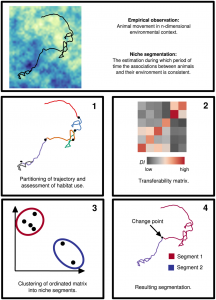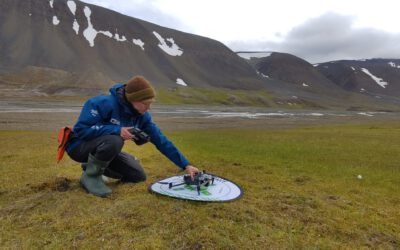 The article “Temporal segmentation of animal trajectories informed by habitat use” in Ecosphere is finally out. Most animals live in seasonal environments and experience very different conditions throughout the year. Behavioral strategies like migration, hibernation, and a life cycle adapted to the local seasonality help to cope with fluctuations in environmental conditions. Thus, how an individual utilizes the environment depends both on the current availability of habitat and the behavioral prerequisites of the individual at that time. While the increasing availability and richness of animal movement data has facilitated the development of algorithms that classify behavior by movement geometry, changes in the environmental correlates of animal movement have so far not been exploited for a behavioral annotation. Here, we suggest a method that uses these changes in individual–environment associations to divide animal location data into segments of higher ecological coherence, which we term niche segmentation. We use time series of random forest models to evaluate the transferability of habitat use over time to cluster observational data accordingly. We show that our method is able to identify relevant changes in habitat use corresponding to both changes in the availability of habitat and how it was used using simulated data, and apply our method to a tracking data set of common teal (Anas crecca). The niche segmentation proved to be robust, and segmented habitat suitability outperformed models neglecting the temporal dynamics of habitat use. Overall, we show that it is possible to classify animal trajectories based on changes of habitat use similar to geometric segmentation algorithms. We conclude that such an environmentally informed classification of animal trajectories can provide new insights into an individuals’ behavior and enables us to make sensible predictions of how suitable areas might be connected by movement in space and time.
The article “Temporal segmentation of animal trajectories informed by habitat use” in Ecosphere is finally out. Most animals live in seasonal environments and experience very different conditions throughout the year. Behavioral strategies like migration, hibernation, and a life cycle adapted to the local seasonality help to cope with fluctuations in environmental conditions. Thus, how an individual utilizes the environment depends both on the current availability of habitat and the behavioral prerequisites of the individual at that time. While the increasing availability and richness of animal movement data has facilitated the development of algorithms that classify behavior by movement geometry, changes in the environmental correlates of animal movement have so far not been exploited for a behavioral annotation. Here, we suggest a method that uses these changes in individual–environment associations to divide animal location data into segments of higher ecological coherence, which we term niche segmentation. We use time series of random forest models to evaluate the transferability of habitat use over time to cluster observational data accordingly. We show that our method is able to identify relevant changes in habitat use corresponding to both changes in the availability of habitat and how it was used using simulated data, and apply our method to a tracking data set of common teal (Anas crecca). The niche segmentation proved to be robust, and segmented habitat suitability outperformed models neglecting the temporal dynamics of habitat use. Overall, we show that it is possible to classify animal trajectories based on changes of habitat use similar to geometric segmentation algorithms. We conclude that such an environmentally informed classification of animal trajectories can provide new insights into an individuals’ behavior and enables us to make sensible predictions of how suitable areas might be connected by movement in space and time.
Successful MSc Thesis Defense by Sharmin Mim on Ability of Random Forest Model to Predict the Mean and,Standard Deviation of Winter Wheats Biomass in Bavaria: A Case Study
Congratulations to Sharmin Mim on the successful defense of her MSc thesis, titled "Ability of Random Forest Model to Predict the Mean and Standard Deviation of Winter Wheat Biomass in Bavaria: A Case Study." Her work focused on the Rhön region, where she combined...







